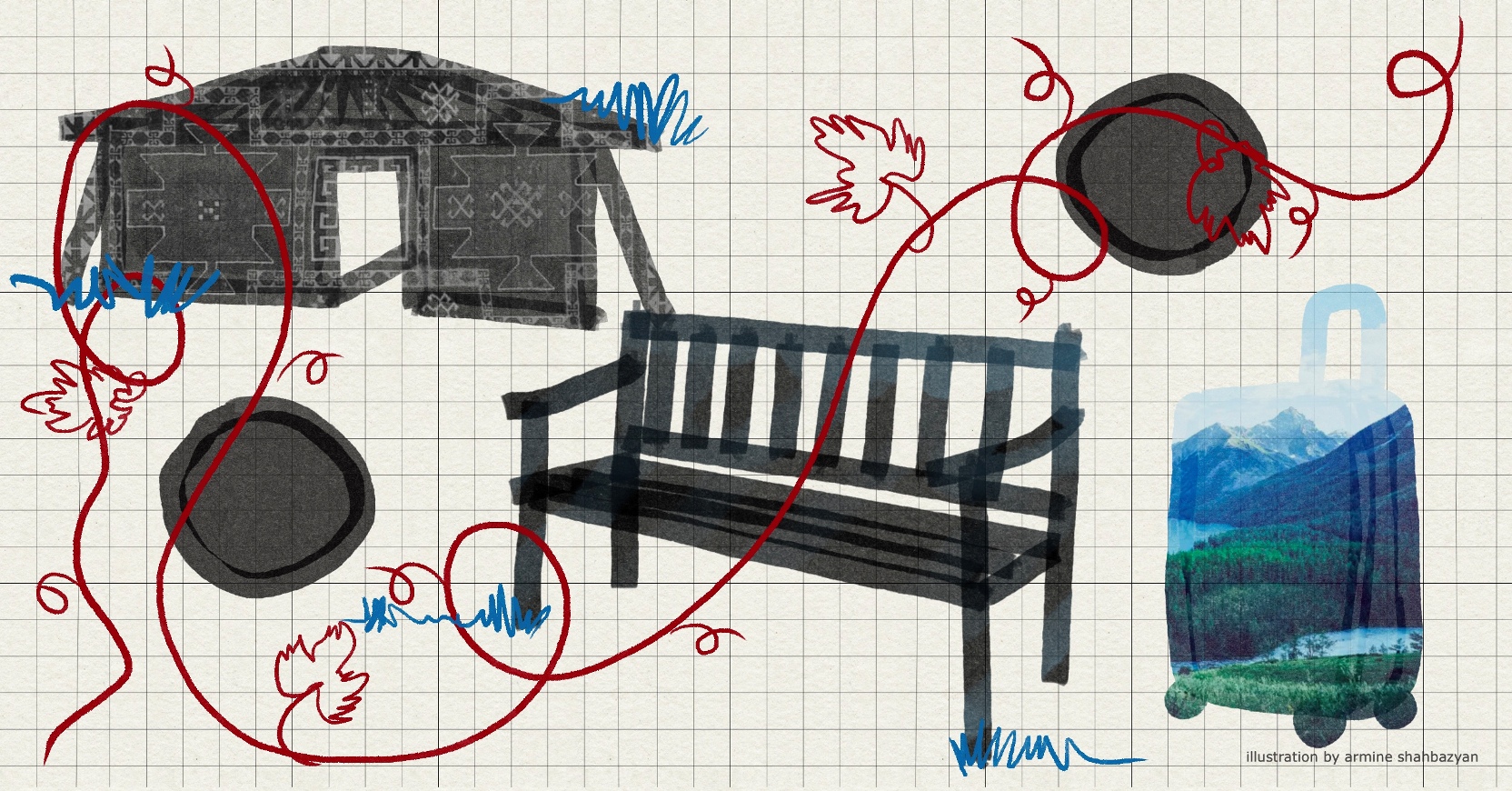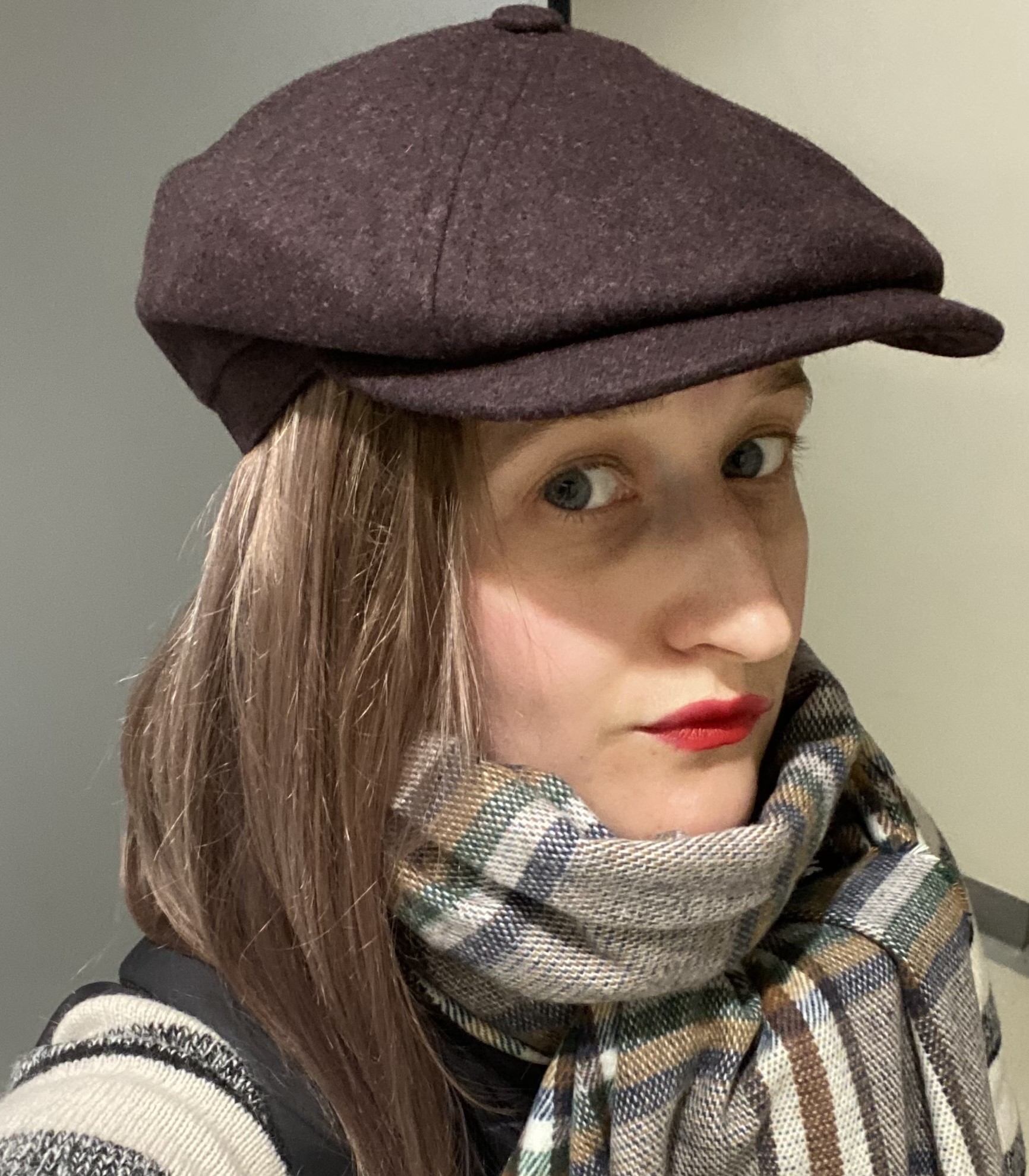
Visiting one post-Soviet state, you can then recognize it in all others – the similar patterns of urban planning and the identical buildings, structures, roads, pipes, wires, tiles, etc. However, an outsider delving inside under the extreme familiarity of the material environment finds an extreme “strangeness” of social interactions and practices. The “Outside In” series is about emplaced paradoxes and nuances. It spotlights the mundane in Armenia’s peripheral locations, where the seemingly unspectacular encounters with people and things allowing us to capture the unique features of the territory.
Listen to the article.
Outside In
Essay 10
It was yet another terribly hot Yerevan summer day in 2023 when I met with architect/artist Maria Kremer for a casual coffee at the Voch Lujs Voch Mut garage café. Despite the heat, life in the courtyard continued; someone hung laundry while another hurried with groceries, and occasionally cars passed by. Sitting under the redemptive shade of a beautiful grapevine on two small stools, with the third serving as our improvised table, we traded stories. Soon it became clear that “Home” was a topic that interested us both. The pace of discussion picked up, intertwined with professional experiences and spiced with personal stories of mobility. The “Home” we were referring to was bricolage, a constant process of becoming, a persistent work-in-progress. A verb, rather than a noun.
As we recall, it all began with the word. For our collective endeavor, this word was conceived on that summer day—Homeing—a fluid process of habituating and domesticating the ever-changing world, where movement—whether migration, old/new nomadism, or displacement—is the rule rather than the exception. What began as a mundane meeting turned into a project,[1] an adventure, a friendship, and a profound self-reflection on what “Home” means to me.
“Outside In” is a series portraying my encounters with places and people in Armenia from the perspective of a stranger. But after over two years of living and working in Armenia—moderately mastering the language, traveling from Bagratashen to Meghri, trading colors for black, preferring Areni over Sauvignon Blanc and aveluk over any other vegetable, writing “jan” instead of “dear”, and getting a red ink tattoo anhnazand [անհնազանդ][2] under the collarbone as a rebellious act against gender norms—can I still be considered a completely unrooted outsider? Where does the thin line between out and in, between house and home, lie? The tenth installment of an “Outside In” essay is precisely about that. So far, the most personal of all.
The Nomad
One day, when I am old and affluent enough to allow myself to slow down, I will sit on a porch of a hut surrounded by greenish-blue mountains and begin my autobiography with an anecdotal story – I was born nowhere to a family of Ukrainian/Russian/Polish/Jewish heritage. Dosatuy village, Chita region, USSR. Metaphorically this village in Eastern Siberia on the border of Russia and China was the backwoods. Literally none of these toponyms exist anymore. The village was resettled and abandoned, the region was renamed, the country collapsed. When I was a four-month-old, my family took an eight-hour flight from Chita to Moscow, never to return again. And what for? There was nothing to return to, just the barren wilderness of the borderland with more bears per square kilometer than people.
Since that first move, I have lived in seven countries and nine cities. At times between several of them, with personal belongings and close people existing in an entangled spatial network. A nomad is someone whose livelihood depends on mobility, who has no constant place of residence. Well, maybe not livelihood, but my wellbeing is definitely linked to movement. To rephrase Descartes: I move, therefore I am. Each new place added to my identity. I became a part of it, as it became a part of me with its scents, colors, noises, music, cuisine, and language expressions. A “rootless cosmopolitan,” I was not really attached to anything and could adapt to nearly everything. Or so I thought.
Where is home? This question startled me. It was with me – my suitcase, my favorite smells of incense and cedarwood, and my transcendently weird Spotify playlist ranging from classical rock to country and Georgian ethno. But apparently the statement above only held up as long as mobility was a free choice. With a semi-voluntary decision to move to Yerevan in 2022 due to the increasing levels of state terror in Russia, I felt something had collapsed. A deep profound sadness overtook me, nostalgia for something I had or imagined that I had. A ghostly opportunity, even if only theoretical, to return to point A. The “white émigré” —Russians escaping the Bolshevik regime—literature of the first half of the 20th century started to unsettlingly resonate with me with its longing for “hugging the birch trees” and suffering as a mode of being. One illusion of stability was gone, the other was yet to be found.
The Bench As a Home
At first Yerevan seemed alien. The colors, the heat, the infrastructure, the straight lines and uncorrupted authority of neoclassical Stalinist architecture. Kond was my escape. With its chaotic snaky streets, layered history of contested narratives, and mundane practices of co-habitation, it is approachable, relatable, on a very human scale.
My encounters with Kond were mostly nocturnal, when the darkness of blueberry nights wrapped one in a tender embrace. Drifting without a particular cause, gazing at the windows, and listening to Armenian folk music reconciled me with the reality of semi-voluntary emigration. During one such stroll, I exited through the tunnel to Leo Street. And there I saw it. Next to a restaurant entrance, surrounded by construction waste, stood a monumental wooden bench. It seemed strangely familiar. Though slightly different in design, it reminded me of the monumental wooden benches in the main building of my Alma Mater, Lomonosov Moscow State University. So many cheat sheets were written there, stories and gossip traded while sitting on those benches. For the first time in a while, I felt a warm feeling of belonging. And it made me crave that bench.
I returned to our rental apartment and told the story to my partner, who, without even blinking, said: “Let’s go.” We arrived at the spot by car around 2 a.m. Dressed in black with a baseball cap covering my face, I was ready to commit a crime of passion. My partner got out, walked around the bench for a while and came back saying that there is no way it will fit into our car. That was it, we left empty-handed. About a week after that night, I traveled to Oxford for an exam. Upon returning, I saw the bench standing covered with a beautiful handmade carpet.
“Once upon a time, a knight in shiny armor went on a conquest…” While I was away, every day after work, my partner went to the restaurant to figure out how to fetch the bench. It turned out, contrary to my initial thinking that the bench had been discarded, it was merely put outside while the restaurant was undergoing renovation. Like any sane person, it did not even occur to the owner that someone might try smuggling something that huge and heavy, almost like the wing of an airplane. After several attempts, marveling at his stubborn persistence, the restaurant manager finally gave in. The bench belonged to a former high-ranking official from the Ministry of Justice. Smuggling the bench, we would definitely make the front pages of the Armenian press: “Russian relocants rob Armenian officials.” But luckily, we made a legal deal. All in all, without damaging our reputation and gaining a story to tell our grandchildren, the bench was acquired for $150 with a carpet on top.
The bench, or rather the BENCH now proudly stands in the living room of my new dwelling. It is a napping place, a sitting place, a place for games, and a source of amusement for guests. Everything in the nomad’s home is functional, lightweight, and mobile. But the monumental solid bench can’t be more opposite to that. And I cannot imagine leaving it behind. It is my hideaway, my shelter, and my story of homeing. Perhaps I am not a nomad anymore? Perhaps, even if constantly dwelling in limbo between outside and inside, Yerevan is now truly home? I have no answer yet, but will ponder about it further with a glass of Tus Reserve sitting on the bench.
Author’s notes:
[1] Homeing is a research art project initiated by Maria Kremer and myself in Yerevan in 2023. It is a space for critical reflection on the concept of Home in times of mobility, displacement, and radical uncertainty. To find out more go to: https://www.homeing.org
[2] As a part of the traditional Armenian marriage ceremony the priest ask the man if he is a master/owner – ter [տեր], and the woman if she is submissive – hnazand [հնազանդ]. Anhnazand is the opposite to that.
See all [Outside In] articles here


